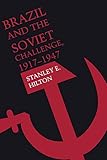Brazil and the Soviet Challenge, 1917–1947 / Stanley E. Hilton.
Material type: TextPublisher: Austin : University of Texas Press, [2021]Copyright date: ©1991Description: 1 online resource (303 p.)Content type:
TextPublisher: Austin : University of Texas Press, [2021]Copyright date: ©1991Description: 1 online resource (303 p.)Content type: - 9781477303566
- 327.81047
- online - DeGruyter
| Item type | Current library | Call number | URL | Status | Notes | Barcode | |
|---|---|---|---|---|---|---|---|
 eBook
eBook
|
Biblioteca "Angelicum" Pont. Univ. S.Tommaso d'Aquino Nuvola online | online - DeGruyter (Browse shelf(Opens below)) | Online access | Not for loan (Accesso limitato) | Accesso per gli utenti autorizzati / Access for authorized users | (dgr)9781477303566 |
Frontmatter -- Contents -- Preface -- 1. Challenge and Response (1917-1930) -- 2. The Debate over Trade and Recognition (1930-1934) -- 3. Red Rebellion (1935) -- 4. Toward the National Security State (1935-1937) -- 5. The Battle on the External Front (1935-1937) -- 6. Coming of the Estado Novo (1937) -- 7. Dictatorship, War, and Internal Security (1937-1941) -- 8. Global Conflict and Rapprochement (1941-1945) -- 9. Cold War Antagonisms (1945-1947) -- Notes -- Bibliography -- Index
restricted access online access with authorization star
http://purl.org/coar/access_right/c_16ec
Between 1918 and 1961, Brazil and the USSR maintained formal diplomatic ties for only thirty-one months, at the end of World War II. Yet, despite the official distance, the USSR is the only external actor whose behavior, real or imagined, influenced the structure of the Brazilian state in the twentieth century. In Brazil and the Soviet Challenge, 1917–1947, Stanley Hilton provides the first analysis in any language of Brazilian policy toward the Soviet Union during this period. Drawing on American, British, and German diplomatic archives and unprecedented access to official and private Brazilian records, Hilton elucidates the connection between the Brazilian elite’s perception of a communist threat and the creation of the authoritarian Estado Novo (1937–1945), the forerunner of the post-1964 national security state. He shows how the 1935 communist revolt, prepared by Comintern agents, was a pivotal event in Brazilian history, making prophets of conservative alarmists and generating irresistible pressure for an authoritarian government to contain the Soviet threat. He details the Brazilian government’s secret cooperation with the Gestapo during the 1930s and its concomitant efforts to forge an anti-Soviet front in the Southern Cone. And he uncovers an unexplored aspect of Brazil’s national security policy, namely, the attempt to build counterintelligence capabilities not only within Brazil but also in neighboring countries. While the history of the Brazilian communist movement has been extensively studied, this is the first work to explore how images of the Soviet Union and its policies influenced the Brazilian foreign policy elite. It will be important reading for all students of twentieth-century political history.
Mode of access: Internet via World Wide Web.
In English.
Description based on online resource; title from PDF title page (publisher's Web site, viewed 26. Apr 2022)


